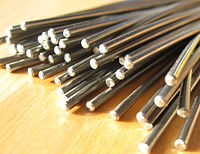
Photo from wikipedia
The aim was to explore the biological effect of nickel (Ni) and titanium (Ti) ions released from dental alloys. NiTi alloy were exposed to 40 mL of artificial saliva (pH = 4.8, t = 37 °C).… Click to show full abstract
The aim was to explore the biological effect of nickel (Ni) and titanium (Ti) ions released from dental alloys. NiTi alloy were exposed to 40 mL of artificial saliva (pH = 4.8, t = 37 °C). The dynamics of Ni and Ti ions release during corrosion were recorded on the 3th, 7th and 14th day. Biological effect of Ni and Ti ions released from alloy was explored on cell lines of human tongue CAL 27, liver Hep G2 and colon Caco-2. Neutral Red uptake assay for the estimation of cell viability/cytotoxicity and 2',7'-dichlorofluorescein diacetate fluorimetric assay for reactive oxygen species were used. Cells were exposed to the following concentration of corrosion products: 5.0×, 1.0×, 0.5 and 0.1× during the period of 24, 48 and 72 h. To check the effect of each metal separately, cells were exposed to nickel-chloride and titanium-dioxide of corresponding concentration. The release of Ni is higher than of Ti (15.1-30.4 μg/L for Ni and 9.0-17.3 μg/L for Ti, respectively) and 5× higher concentrations are needed to induce cytotoxic effect. Ni and Ti ions alone do not induce a major cytotoxic effect, but their combination does indicating their synergistic effect. Increase in concentration of Ni and Ti tends to increase cytotoxicity, Ti more than Ni. Cytotoxicity and induction of free radicals are in strong positive linear correlation. Ions released from NiTi alloy during 14 days do not induce significant cytotoxic effect and would not have a clinically important impact. Cytotoxic effect is largely the result of the induction of free radicals.
Journal Title: Toxicology and applied pharmacology
Year Published: 2019
Link to full text (if available)
Share on Social Media: Sign Up to like & get
recommendations!